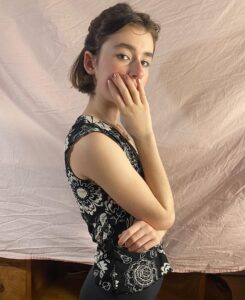
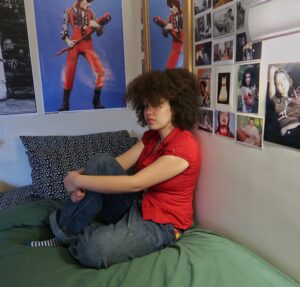
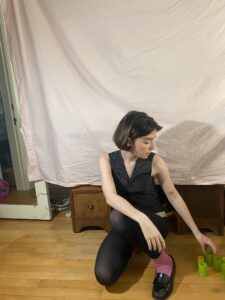
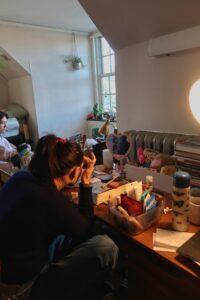
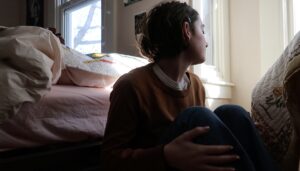
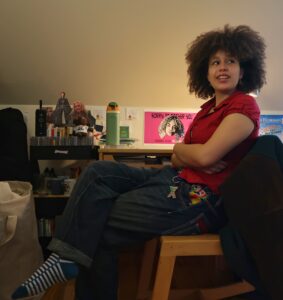
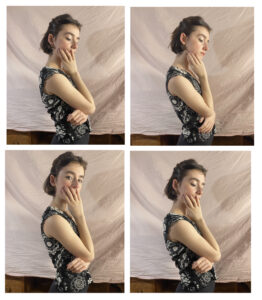
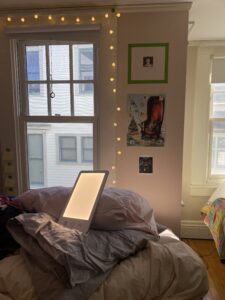
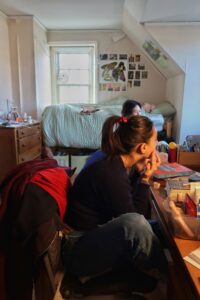
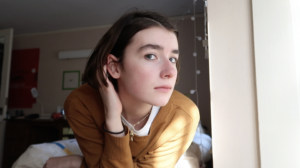
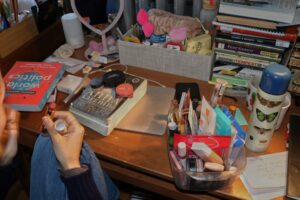
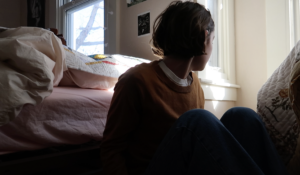
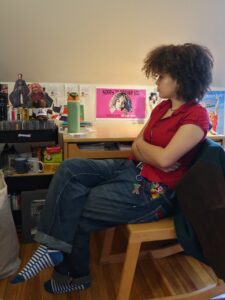
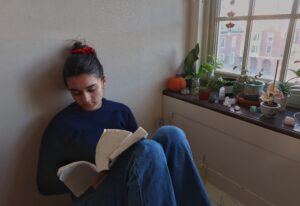
My idea for this final project was to remix a photoshoot from 2003 of Smith students at the time. The photoshoot features a bunch of young people shot in front of different and specific backdrops. They each have one specific setting and vibe. I love this photoshoot because it definitely pushed some boundaries of representing young people, especially young women. The photos have a real feeling of youth.
I wanted to do something similar and also shoot (with a camera) Smith students. But I wanted to update the idea by shooting in a more real setting. My goal for my project was to capture students in a way similar to the original shoot in the sense that I wanted the photos to feel natural and comfortable. But I wanted them to include a more diverse range of students, reflecting the current make up of the student body now as opposed to twenty years ago and I also wanted them to appear in spaces that were clearly theirs, that expressed a trueness to their element.
In order to accomplish this I decided to shoot three models: myself, my friend Maya and my friend Uma. For Uma and Maya’s photos I decided to have the setting be within their dorm rooms. And in order to accomplish sort of a lived in feeling I asked them not to change their spaces to be cleaner.
I decided to use a DSLR camera from the library to capture a crisper image and used Lightroom software for post processing.
The way I think of a successful critique based on our readings and discussions in class is the step that comes before a successful remix. If critique can be defined by Judith Butler as based on subject and includes a certain amount of questioning of power and motivation. The way I employed critique was by looking for missing pieces or perspectives in the original work.
And even though for 2003, the photoshoot of Smith students was relatively quite boundary breaking, for 2023 it also reveals some gaps. Those gaps, within my critical lens, were lack of racial diversity and a rigid curatorial setting.
While taking this class and in working on this project as well I’ve been thinking about remixing, originality and identity. I’ve come to the conclusion that I think that identity is awfully amorphous even though we often struggle to pin it down.
And I think that one way of trying to define our identity is tied to what we consume including lots of different kinds of art and artists.
In looking to the art world to find our own identity it seems inevitable that we would often find ourselves missing from certain corners. And then comes remixing. Remixing is a way to alter a work to become more inclusive, focused, or just in service to a different purpose than the original. Hence what my project became. I remixed the 2003 photoshoot to serve a slightly different purpose and to present the same subject through a new lens.
Originality I’ve found is hard to pin down or put in a box. I’ve come to understand as the closest true definition of originality to be a work that most likely has consciously or subconsciously come from the intake of many other works that aims to serve a purpose that those works have not served before. Wordy, I know. But I’m afraid it must be that way, at least in my understanding.
So I would certainly say that my photoshoot was an original work. I think unjustified stealing in the art world happens when the purpose of the duplication is just to take credit for something that already exists, or put it into a space where it serves essentially the same purpose out of laziness or selfishness.
Not only does critique lead to a good remix but critique can also be seen as a form of remix in itself.
In order to remix something you need to do a version of critique. If we defined critique as involving questioning power or motivation it becomes clear that in order to remix well, one needs to first question the motivation or power behind the original work. So, in a sense, one can’t remix without performing some version of critique.
I think that my project reflects this concept through my process. First, around last year I came across the original photoshoot and I loved it of course. But I also noticed some missing pieces. And in order to notice those missing pieces I had to employ a level of questioning the original motivation.
In my case the missing pieces that I wanted to add in were a more racially diversified casting of models. And secondly I wanted to establish a more realistic sense of space.
In order to identify those things I did have to think more critically about the images, beyond the fact that they were cool and pleasurable to the eye. And I would add to the previous definition that critique can be defined by any observatory act that goes beyond passive experience, any and most inquisitive interaction with it.
According to these circumstances, originality inevitably includes a lot of stealing. Healthy stealing may be justified, compassionate and curious stealing. This class among other things has definitely taught me that. That good work comes from curiosity, excitement and a little bit of diversified kleptomania.
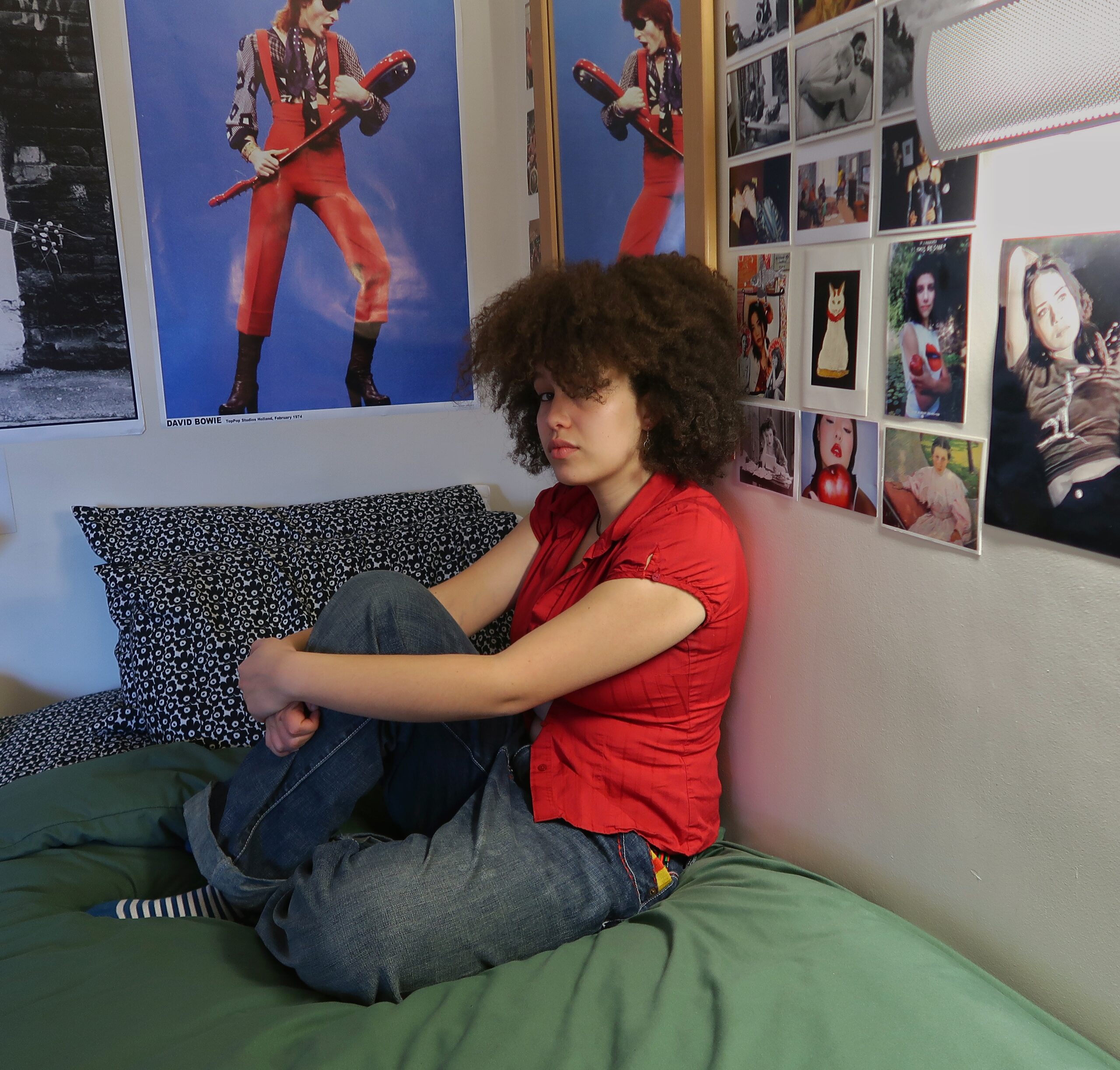
Comments are closed, but trackbacks and pingbacks are open.